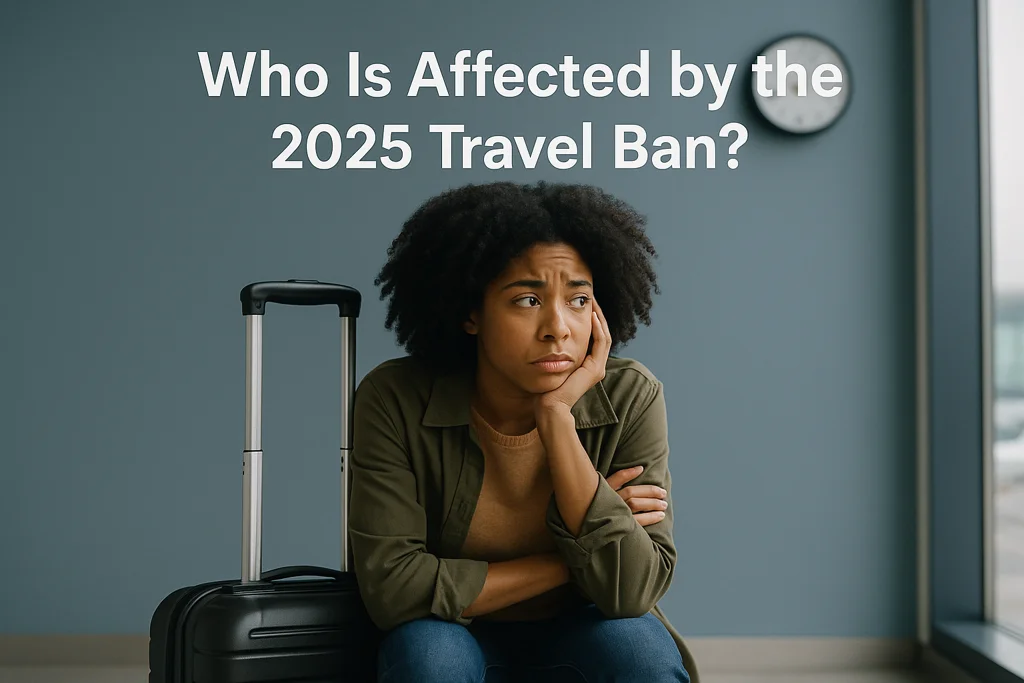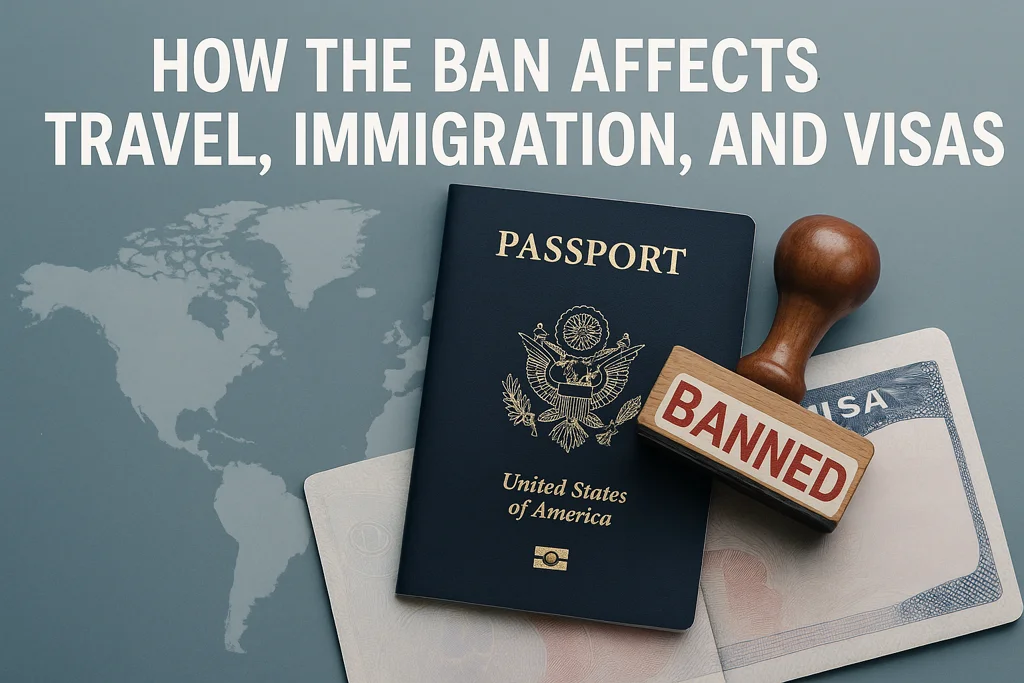So here we go again… another executive order, another round of chaos at airports, and another set of communities scrambling to figure out what the heck just happened.
The Trump 2025 Travel Ban is a reboot—some say a “remastered edition”—of the controversial 2017 travel ban that targeted several Muslim-majority countries. But this time around? It’s not just about religion or nationality. It’s broader. It’s framed around “national security upgrades”, with a longer list of countries, new visa categories, and a lot more red tape.
Let’s start from the top. 📜
In January 2025, shortly after his return to the Oval Office, Trump issued an executive order titled “Preserving the Integrity of the United States Immigration System.” Sounds innocent enough, right? Except buried in the language were the names of nearly a dozen countries flagged for “non-cooperation” or “high-risk profiles”—and a few of them weren’t on the 2017 list. Countries like Nigeria, Pakistan, Venezuela, and even Cuba got added to the mix this time.
Unlike the original ban, which focused on entry restrictions, the 2025 version goes further:
- Suspensions of student visas for specific nations
- Halts on refugee resettlement
- Increased screening for green card applicants
- And even restrictions on dual nationals with ties to flagged countries
That last one? Yeah, it’s messy. Dual citizens of, say, France and Iran are stuck in a weird limbo. Technically they hold a “safe” passport, but their Iranian connection flags them for extra scrutiny. Cue the confusion at the embassy. 🌀
What’s different now compared to 2017 is also the implementation:
It’s phased, not instant. Homeland Security rolled out Tier 1 countries first (like Iran, Syria, and North Korea), followed by Tier 2 countries (like Nigeria and Venezuela). The slow roll gives people time to “adjust,” but let’s be real—it’s still disruptive AF for families trying to plan travel or immigration steps.
Also—this time, no court freeze happened right away. The language of the order was crafted more carefully, likely in anticipation of legal pushback. Some say it’s “Supreme Court-proof.” Others call it clever censorship in policy form.
Bottom line?
This isn’t a rehash. It’s an expansion. And if you think you’re not affected… think again.
🟪 Who Is Affected by the 2025 Travel Ban?

Short answer? Way more people than last time.
This isn’t just about folks with a certain passport. The 2025 version of the travel ban is layered—like one of those bureaucratic onions that makes you cry with every peel. 🧅😭
Let’s break down the groups most affected:
📌 Citizens of Targeted Countries
If you’re from a country listed in Tier 1 or Tier 2 of the executive order, your visa application is likely frozen or under “review.” These countries include:
- Iran, Syria, North Korea (classic Tier 1)
- Nigeria, Sudan, Venezuela, Pakistan, Yemen, Cuba (among others)
Whether it’s a tourist visa or a work permit, it’s now either suspended or under heavy scrutiny. And the vague language in the order? Yeah, it leaves room for “discretionary denial.” That’s bureaucrat-speak for nope.
🛂 Green Card Holders & Dual Citizens
This one hits hard. Green card holders from targeted nations—or those with dual citizenship involving one of the listed countries—are being flagged for secondary screenings and “status reevaluation.” Some have been denied re-entry, even with legal U.S. residency.
Imagine living in the U.S. for 10 years, visiting family abroad, and suddenly being told you can’t come back. It’s happening. And it’s terrifying.
🎓 Students & Skilled Workers
International students, especially from Muslim-majority or politically flagged countries, are caught in the mess. Schools have already reported massive delays in F-1 visa approvals, even for returning students. Meanwhile, H-1B and O-1 visa holders from those regions? Stuck in limbo.
One STEM student from Nigeria was told her visa interview would be rescheduled… in nine months. By then, she’ll have missed a full academic year. 🤯
🧳 Tourists and Families
Family-based visas, fiancé visas, and even B-1/B-2 visitor visas are seeing a “temporary pause.” U.S. citizens who applied for their spouse or parents are finding their petitions caught in processing purgatory.
It’s not just travel. It’s about weddings postponed. Sick parents unseen. Lives on hold.
🤝 Humanitarian and Refugee Cases
The 2025 ban also includes a freeze on refugee resettlements from countries with “unstable political regimes.” In practice? That means thousands of displaced people are now facing longer wait times—or outright rejections.
And get this: even urgent medical cases are being slowed down. One advocacy group reported a 12-year-old Syrian child awaiting surgery in the U.S. was denied travel clearance due to the new restrictions.
Bottom line: the 2025 ban casts a much wider net than the one before it. Even if you’re not directly affected, you probably know someone who is.
🟥 Legal Challenges and Reactions to the Ban

If you thought the legal drama from 2017 was intense… welcome to Season 2.
The Trump 2025 Travel Ban didn’t just ruffle feathers—it lit a fire under civil rights groups, immigration attorneys, and even some state governments. Within days of the executive order dropping, lawsuits were being drafted faster than you could say “unconstitutional.” ⚖️🔥
📜 Civil Liberties Groups Take the Lead
Organizations like the ACLU, CAIR, and National Immigration Law Center were among the first to file federal injunctions. Their argument? The ban is just a polished version of the old “Muslim ban”—repackaged with better legal language but the same discriminatory core.
And they’re not wrong. Several of the same countries are targeted again, and the communities hit hardest are still predominantly Muslim or non-white.
🏛️ State Governments Push Back
California, New York, Illinois, and even some swing states joined in to sue the federal government. Their main concern? Economic impact, damage to universities, and the strain on local immigration services.
One lawsuit from Washington state straight-up called the order “vindictive policymaking disguised as national security.” Spicy stuff.
🌍 Diplomatic Fallout
International allies didn’t stay quiet. Leaders from Canada, France, and Germany issued joint statements condemning the policy. Several embassies in D.C. reportedly requested emergency meetings with the State Department.
And in a bold move, the African Union labeled the ban “a hostile act,” especially due to the inclusion of Nigeria and Sudan.
🪧 Protests Hit the Streets (Again)
If you live near a major city, you’ve probably seen the signs already.
“NO BAN, NO WALL,”
“FAMILIES BELONG TOGETHER,”
“IMMIGRANTS MAKE AMERICA GREAT.”
From JFK to LAX, airport protests lit up almost immediately. People showed up with snacks, signs, and even lawyers offering free legal aid to stranded travelers. It felt like 2017 all over again—only this time, more organized.
🧠 Court Strategy: Smarter But Still Controversial
Unlike the first round, the 2025 version was crafted to survive legal scrutiny. It references national security reviews, compliance audits, and “visa overstay rates”—terms designed to sound objective and lawful.
But critics argue it’s all smoke and mirrors. And even if the Supreme Court leans conservative, it might have to wrestle with the implications for constitutional rights—again.
No matter how you slice it, legal resistance is alive and loud. Whether it works? That’s a question still making its way through the courts.
🟦 How the Ban Affects Travel, Immigration, and Visas

Here’s where the rubber really hits the runway—literally. ✈️
The 2025 travel ban isn’t just some legal abstraction. It’s messing with real people’s lives in real time, from canceled flights to immigration cases grinding to a halt. And yeah… the ripple effects? Massive.
🛬 Airports: The Frontline Mess
Let’s talk about the madness at U.S. entry points.
Airline staff are confused, Customs and Border Protection (CBP) officers are overworked, and travelers from flagged countries are facing secondary screenings that take hours—or end in refusal.
There have been reports of people being denied boarding overseas, even with valid visas, simply because their country made the ban list. The guidance is murky, and not all airport staff are interpreting it the same way. You could fly out of London and get in—but get blocked out of Dubai.
One Nigerian woman described being stopped at JFK for five hours, even though she had a valid F-1 visa and proof of university enrollment. Her words?
“They treated me like I was a threat just because of my passport.” 💔
🕐 Visa Processing Delays (Like, Really Bad Delays)
If you’re applying for a visa from a flagged country, good luck hearing back anytime soon.
- Student visas (F-1) are on hold for entire cohorts.
- Tourist visas (B1/B2) are “under administrative review”—aka stuck in the dark zone.
- Family reunification visas are being delayed without explanation.
- Some green card applications are simply… not moving.
And if you already got approved? Some embassies are recalling visa stamps, which is basically like saying, “We changed our mind.”
⚠️ Risks for Travelers with Valid Documents
Even if you’ve got your papers in order, the reentry process is shaky.
Travelers are being told to “delay non-essential travel” if they’re from or tied to listed countries—even if they’re lawful permanent residents. That’s bananas. 🍌
People with dual nationality are being flagged because of birthplaces or parental origin, not just passport type. Some are being detained and questioned for hours. Others are told they’re “advised not to travel for the time being.”
So, in practical terms? A lot of folks are staying put—scared of getting stuck abroad with no way back home.
💬 Advice from Lawyers & Advocates
Immigration lawyers are urging people to:
- Avoid international travel if you’re from an affected country
- Carry all supporting documents (I-20s, green card copies, employment letters, etc.)
- Monitor State Department and USCIS websites like a hawk 🦅
- Consult legal experts before you fly
And this isn’t just fear-mongering. Cases are piling up. Legal hotlines are slammed. The system is clogged, and people are falling through the cracks.
Bottom line? It’s not just a “ban.” It’s a disruption machine, especially for those trying to build a life, reunite with family, or simply study in peace.
🟨 Economic and Social Impacts of the Ban

It’s easy to look at immigration policy like it’s just red tape and politics. But behind every visa denial or travel delay is a ripple effect—on the economy, communities, and real people just trying to make a living or find safety. 💸💔
The 2025 Trump Travel Ban is already sending shockwaves across multiple sectors—and we’re just scratching the surface.
💼 Tourism Takes a Hit (Again)
In the months after the ban was announced, U.S. tourism dropped from countries on the list—fast. Airlines reported a noticeable dip in ticket sales from targeted regions. Cities like New York, San Francisco, and Los Angeles—normally magnets for international visitors—are seeing fewer bookings and more cancellations.
Tourism boards are scrambling to run damage control campaigns, but the message is clear: if people feel unwelcome, they don’t come.
🎓 Higher Education Struggles
Universities, especially ones that rely on foreign students, are panicking quietly. International students often pay full tuition, supporting everything from scholarships to research funding.
Now? Students from affected countries can’t get visas, can’t renew them, or are too scared to leave the U.S. for fear of not being allowed back in. Schools like MIT, Stanford, and even smaller public universities are lobbying hard for exemptions—but so far? Radio silence from Washington.
One college counselor put it bluntly:
“We’re watching years of international relationship-building go up in smoke.”
🧠 Skilled Workers: Vanishing Talent
The tech industry’s not happy either.
With tighter rules on H-1B and O-1 visas, high-skilled talent from affected nations is either stuck or giving up. Some companies are already reporting recruitment drops and missed deadlines on projects that relied on international experts.
And let’s not forget: the U.S. healthcare system has a high number of immigrant doctors and nurses—many from countries now on the no-fly list. Small hospitals, especially in rural areas, are now bracing for staffing shortages.
👪 Family Separation & Social Anxiety
It’s not just institutions feeling the heat—families are being torn apart.
- Spouses stuck overseas
- Children unable to reunite with parents
- Elderly relatives dying without loved ones present
It’s brutal. And the emotional toll? Even worse than the logistical one. The uncertainty, the helplessness—it’s causing anxiety, depression, and trauma in communities that already felt targeted.
🏙️ Local Communities Feel the Strain
From small businesses to religious centers, local immigrant communities are seeing their foundations shaken. People are canceling travel, skipping work, and even avoiding public events because of fear of ICE detainment or profiling.
Mosques and community centers are doubling down on support services—legal clinics, counseling, rapid-response teams—but resources are limited.
What’s happening isn’t just policy—it’s people. And the cracks are starting to show.
🟪 Conclusion: Staying Resilient in a Time of Uncertainty
Let’s be honest—this isn’t easy. The Trump 2025 travel ban has thrown a wrench into lives, dreams, and entire family plans. It’s stressful, confusing, and for many, deeply personal. 🥺
Whether you’re a student stuck mid-semester, a parent waiting on a visa for your child, or someone who just wants to visit family without fearing detention, this ban has created a sense of instability that’s hard to shake.
But here’s the thing: you’re not powerless.
Yes, policies can change overnight, but so can community action, legal victories, and awareness. And you’re already doing something important—getting informed.
Let’s recap some key takeaways:
- The 2025 ban is broader and more complex than the 2017 version
- It affects multiple categories: immigrants, dual citizens, students, workers, and families
- Legal pushback is underway—but implementation is already causing disruption
- Being prepared—legally, emotionally, and logistically—is essential
Don’t wait for the situation to improve on its own. 📣
- Share this guide with others who might be impacted
- Join online or local communities offering support
- If you have the means, consider donating to immigrant legal defense organizations
- And most of all: stay alert, stay grounded, and know that you are not alone
Policies come and go. But people? People fight back. People adapt. People overcome.
Hang in there. We see you. 💪🌍
📚 Further Reading & Resources
🛂 USCIS – Guidance on Discretionary Denials & Security Reviews
Understand how USCIS applies national security and fraud indicators in visa adjudications.
🔗 https://www.uscis.gov/policy-manual/volume-1-part-e-chapter-8
🧳 U.S. State Department – Visa Restrictions Based on National Security
Country-by-country breakdown of current visa suspensions and heightened screening.
🔗 https://travel.state.gov/content/travel/en/us-visas/visa-information-resources/temporary-restriction.html
⚖️ ACLU – Legal Challenge to Travel Ban 2.0 and Beyond
The ACLU’s archive of litigation, legal briefs, and ongoing challenges against nationality-based bans.
🔗 https://www.aclu.org/cases/trump-travel-bans
🎓 NAFSA – Travel and Visa Updates for International Students
Continuously updated alerts on how immigration changes affect students and academic institutions.
🔗 https://www.nafsa.org/regulatory-information/travel-and-visa-updates
🌍 Migration Policy Institute – Explainer: Trump’s 2025 Travel Restrictions
In-depth policy brief on the new ban’s scope, differences from 2017, and impact on global migration.
🔗 https://www.migrationpolicy.org/news/us-travel-ban-2025-expanded-impact
🩺 American Hospital Association – Immigration Policy & Health Workforce Concerns
Analysis of how immigration restrictions affect staffing in underserved hospitals.
🔗 https://www.aha.org/news/headline/2024-12-14-immigration-restrictions-threaten-health-care-workforce
🪧 CAIR – Know Your Rights at Airports and Ports of Entry
Essential guidance for travelers who may face secondary screening or detention.
🔗 https://www.cair.com/know-your-rights/when-interacting-with-law-enforcement-at-airports/
